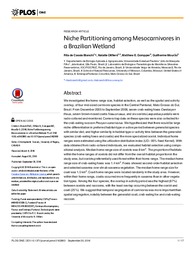Niche partitioning among Mesocarnivores in a brazilian wetland.
Niche partitioning among Mesocarnivores in a brazilian wetland.
Author(s): BIANCHI, R. de C.; OLIFIERS, N.; GOMPPER, M. E.; MOURAO, G.
Summary: Was investigated the home range size, habitat selection, as well as the spatial and activity overlap, of four mid-sized carnivore species in the Central Pantanal, Mato Grosso do Sul, Brazil. From December 2005 to September 2008, seven crab-eating foxes Cerdocyon thous, seven brown-nosed coatis Nasua nasua, and six ocelots Leopardus pardalis were radio-collared and monitored. Camera trap data on these species were also collected for the crab-eating raccoon Procyon cancrivorus. Was hypothesized that there would be large niche differentiation in preferred habitat-type or active period between generalist species with similar diet, and higher similarity in habitat-type or activity time between the generalist species (crab-eating foxes and coatis) and the more specialized ocelot. Individual home ranges were estimated using the utilization distribution index (UD? 95% fixed Kernel). With data obtained from radio-collared individuals, we evaluated habitat selection using compositional analysis. Median home range size of ocelots was 8 km2. The proportionof habitats within the home ranges of ocelots did not differ from the overall habitat proportionin the study area, but ocelots preferentially used forest within their home range. The median home range size of crab-eating foxes was 1.4 km2 . Foxes showed second-order habitat selection and selected savanna over shrub-savanna vegetation. The median home range size for coati was 1.5 km2 . Coati home ranges were located randomly in the study area. However, within their home range, coatis occurred more frequently in savanna than in other vegetation types. Among the four species, the overlap in activity period was the highest (87%) between ocelots and raccoons, with the least overlap occurring between the ocelot and coati (25%). It is suggest that temporal segregation of carnivores was more importantthan spatial segregation, notably between the generalist coati, crab-eating fox and crab-eating raccoon.
Publication year: 2016
Types of publication: Journal article
Unit: Embrapa Pantanal
Observation
Some of Embrapa's publications are published as ePub files. To read them, use or download one of the following free software options to your computer or mobile device. Android: Google Play Books; IOS: iBooks; Windows and Linux: Calibre.
Access other publications
Access the Agricultural Research Database (BDPA) to consult Embrapa's full library collection and records.
Visit Embrapa Bookstore to purchase books and other publications sold by Embrapa.

